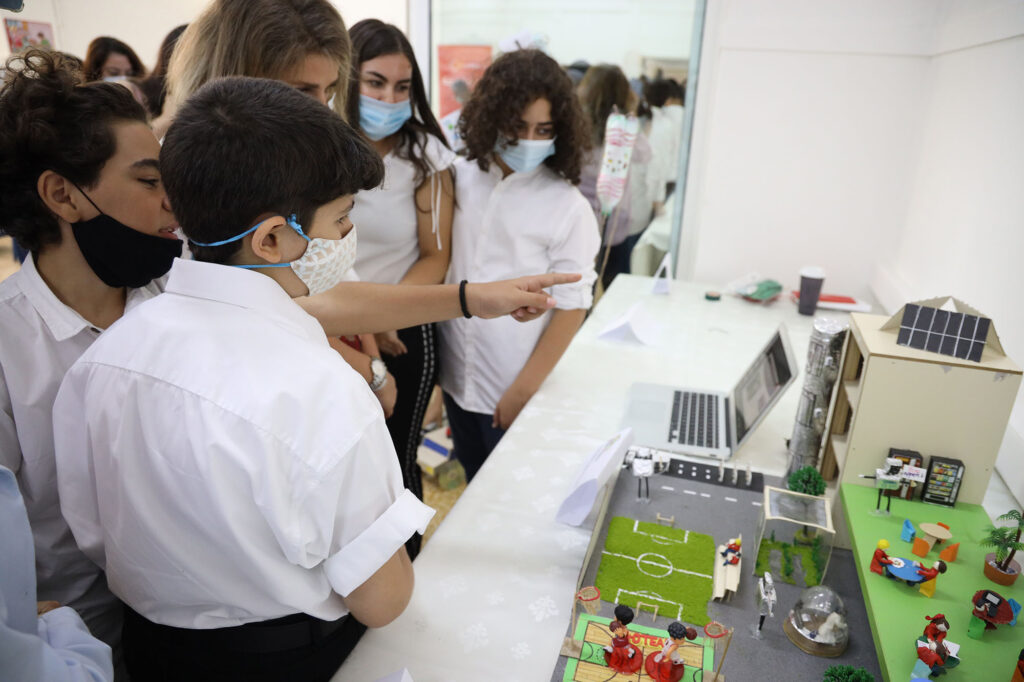Project Context
Nestled in our beloved city of Beirut, Makassed Khaled Bin El Walid High School (KBWH) stands committed to cultivating a sustainable and equitable society by empowering students with leadership potential. Equipped with 21st-century skills such as Information and Communications Technology (ICT) integration, collaboration, critical thinking, and communication, the teachers at KBWH strive to provide an enriching educational experience for their students. However, the school faced a challenge in providing a dedicated space for students to explore and practice Science, Technology, Engineering, and Mathematics (STEM) as well as Entrepreneurship skills.
Project Description
Driven by a shared vision, the school team at KBWH embarked on developing their students’ digital skills and fostering a maker mindset. They established an advanced makerspace with three divisions: (1) an open workshop for hands-on projects, (2) a coding space powered by The Little Engineer curriculum, and (3) a dedicated presentation area. It was fully furnished with the required tools including 3D printers, robotic toolkits, that allow students to develop their prototypes, ipads and laptops, among other necessary tools.
To ensure student engagement and ownership, the makerspace committee was formed, consisting of students selected based on their interests and abilities. Students took ownership of creating comprehensive policies that were formulated, approved, and distributed throughout the school community. To effectively promote the makerspace’s services, flyers and brochures were also prepared and distributed to neighboring schools, encouraging others to leverage the space and to encourage shared learnings.
The makerspace became a hub for students to unleash their creativity and apply personalized learning strategies. It provided a safe space where students felt free to express themselves without the fear of failure. The presence of different workstations within the makerspace encouraged collaboration among students, fostering a vibrant community of learners that welcomed students from diverse backgrounds, including foreigners, and those with special needs.
To evaluate the impact of the makerspace initiative, the school team employed two main measurement tools. A pre-post survey captured the subjective student perception, allowing for a comprehensive understanding of the changes experienced during the 100-day period. Additionally, an objective rubric was utilized to assess the learning outcomes, providing a quantitative assessment of the progress made by students.
Results reflect that engaging in such projects transformed students into adept problem-solvers, while also nurturing their critical thinking skills. They learned to carefully analyze and process evidence, strengthening their decision-making abilities in the process.

Achievements to Date
- Through this transformative initiative, 30 remarkable innovative projects were created, serving as a testament to the empowerment of students in fostering their creativity, technology expertise, and digital skills.
Examples include:
-An inclusive sink facility designed for students with disabilities, fostering social justice and promoting a sense of inclusion.
-School recyclables were used to create solar panels, promoting the adoption of eco-friendly energy consumption
-A car that works through magnetic force was designed by students to conserve and preserve energy. - Within a span of 100 days, students in cycles three and four not only comprehended scientific theories behind these projects but also successfully executed them, showcasing their acquisition of essential 21st-century skills. Their ability to apply these skills to solve real-life problems demonstrated a notable increase, as measured through a comprehensive survey and rubric assessment, with percentages rising from 27% to an impressive 73%.
- The collective vision of the school community highlighted the need for a dedicated STEM lab within the premises. To bring this vision to life, an action plan was meticulously prepared, featuring a committee of passionate teachers who will spearhead the implementation of the STEM lab.
- The students have used the Makerspace as a science STEAM club for elementary students.
- As part of transforming this 100-day project for a whole school approach, the school embarked on creating a kindergarten curriculum.
The Human Heartbeat
The students at KBWH have acquired hands-on experience in utilizing 3D printers and other tools to bring their own creations to life. “I’ve learned how to use 3D printers, and other tools to create my own projects. I’ve also learned how to code, design, and problem-solve. The best part about the Makerspace is the community. The other students are all really passionate about STEAM, and they’re always willing to help each other out. I’ve made some great friends in the Makerspace, and I’ve learned so much from them.
If you’re interested in STEAM, I highly recommend checking out the Makerspace at KBWH College. It’s a great place to learn new skills, meet new people, and have fun.” says Rayan, a student at KBWH.
